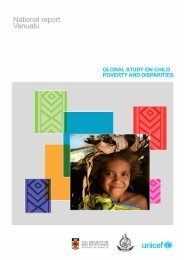A Strategic Assessment of the Children's Services Industry
A Strategic Assessment of the Children's Services Industry
A Strategic Assessment of the Children's Services Industry
- No tags were found...
You also want an ePaper? Increase the reach of your titles
YUMPU automatically turns print PDFs into web optimized ePapers that Google loves.
STRATEGIC ASSESSMENT OF THE CHILDREN’S SERVICES INDUSTRY4.5 Affordability and escalating pricesThe issue <strong>of</strong> affordability is an important one in <strong>the</strong> current debate about extending serviceson a universal basis. This is especially <strong>the</strong> case as children from disadvantaged backgroundsuse child care and preschool services less frequently than <strong>the</strong>ir peers. As demonstrated insection 2.4, low family income, Indigenous and CALD status, geographic location anddisability all affect <strong>the</strong> likelihood <strong>of</strong> children attending early childhood services.We have not been able to identify international research on mixed markets that specificallyexamines <strong>the</strong> issue <strong>of</strong> affordability and escalating prices. In Australia, publicly availableCommonwealth data on <strong>the</strong> costs <strong>of</strong> child care are minimal. They tend to show similar costs(fees) between <strong>the</strong> sectors. There are two issues here, however, that need to be kept separate:• Affordability <strong>of</strong> services to parents• Value for money (<strong>the</strong> connection between fees charged and cost components).Recently, for example, some providers have been criticised for fee rises coinciding with <strong>the</strong>increase in <strong>the</strong> CCTR. There is obvious potential, in a scheme such as <strong>the</strong> CCTR, forpr<strong>of</strong>iteering. More needs to be known about <strong>the</strong> reasons for <strong>the</strong> rise in prices. Are increasedfees <strong>the</strong> result <strong>of</strong> increases wages, enhanced conditions and/or <strong>the</strong> employment <strong>of</strong> more highlyqualified staff, for example, or are <strong>the</strong>y due to business pressures and/or <strong>the</strong> desire to increase<strong>the</strong> surplus (in non-pr<strong>of</strong>it settings) or pr<strong>of</strong>it (in for-pr<strong>of</strong>its)? Without such information, it isdifficult for governments to know whe<strong>the</strong>r <strong>the</strong>y are getting value for money.4.6 Free preschool in private centresBoth New Zealand and <strong>the</strong> UK have experienced difficulty in delivering ‘free’ preschool toparents through privately-owned centres. Private providers resisted this, arguing thatgovernment compensation was inadequate. Currently, around 70 per cent <strong>of</strong> New Zealand’sprivate providers <strong>of</strong>fer free preschool, but not necessarily <strong>the</strong> full twenty hours which <strong>the</strong>government aimed to deliver. ABC Learning Centres have chosen not to deliver governmentfunded‘free’ preschool education to New Zealand parents (Mitchell, 2008).The UK has experienced problems in delivering free preschool. A survey in 2005 showed thatover a third <strong>of</strong> parents were paying for ‘free’ early education (Bryson, Kazimirski andSouthwood, 2006). Despite <strong>the</strong> availability <strong>of</strong> 12.5 hours per week <strong>of</strong> free preschool, morethan a quarter <strong>of</strong> families who were using less than <strong>the</strong>ir full quota reported that <strong>the</strong>y still paida fee (Butt et al., 2007: 81). Some providers argued that government funding was insufficientto cover <strong>the</strong> cost <strong>of</strong> 12.5 hours <strong>of</strong> preschool and so <strong>the</strong>y needed to top-up <strong>the</strong> fee or only <strong>of</strong>fer<strong>the</strong> 12.5 hours as part <strong>of</strong> a larger package. In response to this situation, a new Code <strong>of</strong>Practice was introduced in 2006 mandating that parents should not be charged in any way for<strong>the</strong> free preschool entitlement. Despite <strong>the</strong> Code <strong>of</strong> Practice, anecdotal reports suggest thatparents continue to be charged for <strong>the</strong>ir free entitlement (Hill, 2008). Quebec similarlyintroduced new legislation after finding some parents were charged additional amounts, above<strong>the</strong> $7 daily fee for ECEC services.4.7 ConclusionThe mixed market is an important, ongoing feature <strong>of</strong> <strong>the</strong> Australian ECEC industry and iscrucial to this strategic assessment. International evidence and <strong>the</strong> small number <strong>of</strong> studiesconducted in Australia to date suggest that service quality may be lower in for-pr<strong>of</strong>it than innon-pr<strong>of</strong>it services. However, such research needs to be treated with caution. <strong>Services</strong> <strong>of</strong>high quality can be found in all sectors in Australia and, given <strong>the</strong> rapidly changing regulatoryenvironment, fur<strong>the</strong>r research is needed to test <strong>the</strong> relevance <strong>of</strong> international studies and to40
















